Rice Architecture
21EM_X06
EQUILIBRIUM MODEL / EXPERIMENT SIX
Valerie Elizondo
Madeline Ju
Amber Wang
The idea of a seesaw is nothing new, but in this project our group decided to explore the reaction of a stable plank to three different factors: the length of a peg protruding from the bottom of the platform, a changing fulcrum point, and altering the angle and position of the weight of the cube on the other end of the plank. Another constraint we added to our series was the idea of using the platform to its fullest potential, meaning that we would use fragments of it to create both the cube/weight and the plank. By creating the grid of ¼” holes, we created a system that allows for infinite iterations of plank angles both horizontally and vertically, cube placement along the plank, and points where dowels could be placed to create tension along with the string to hold up the cube. To explain the system, we may look at model 1. We rested the plank along the lower right corner of the rectangular cutout with the fulcrum being about 9 inches from the left end of the plank.
PHYSICAL MODEL







DIGITAL MODEL



















